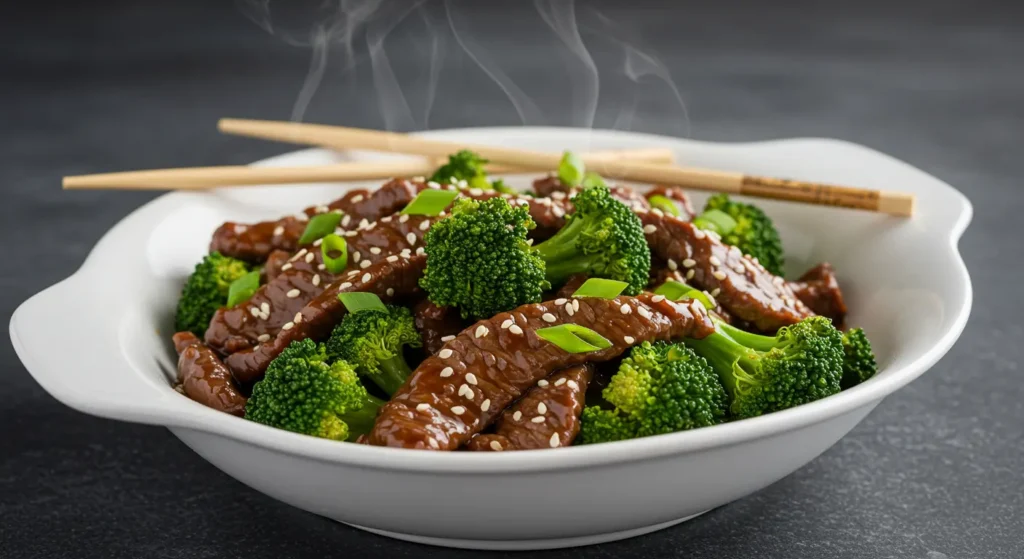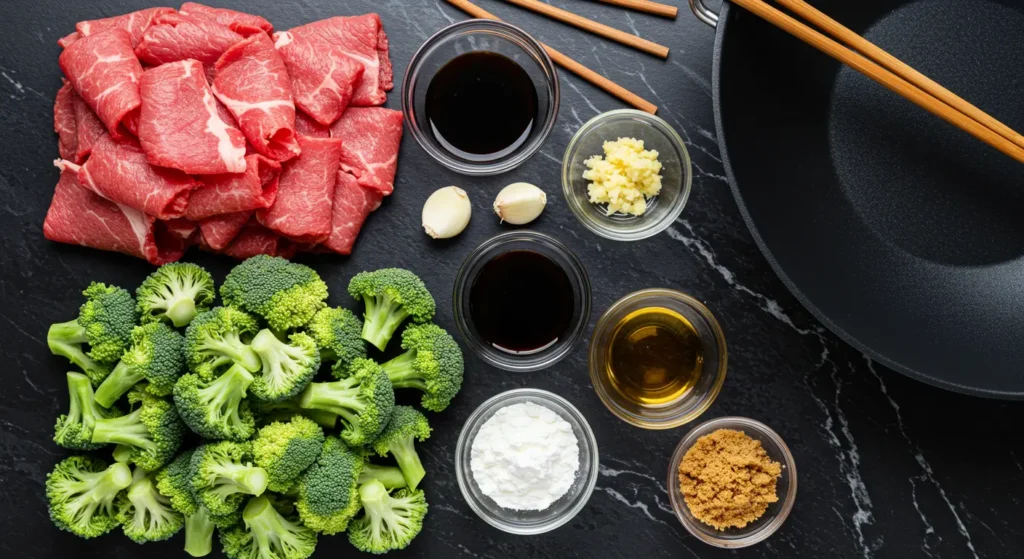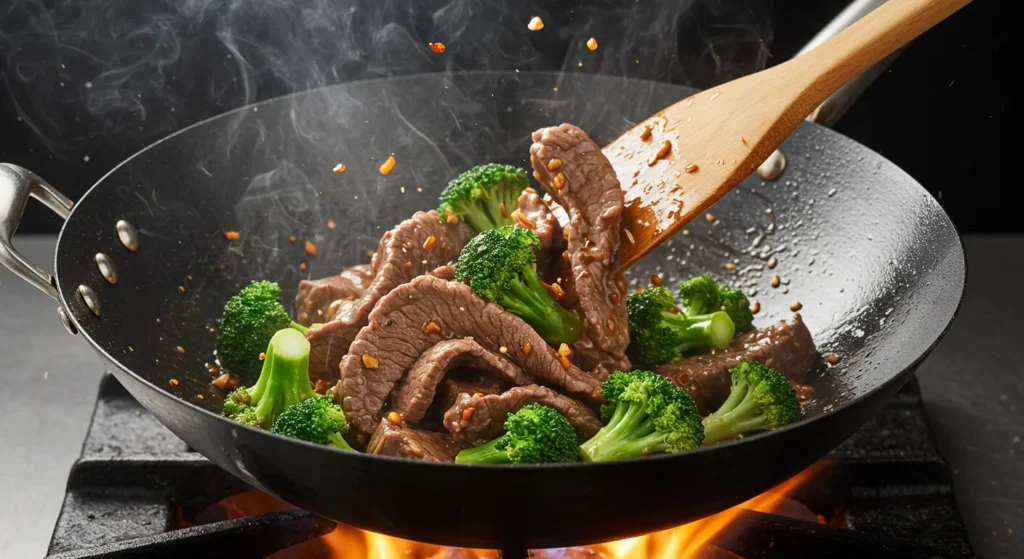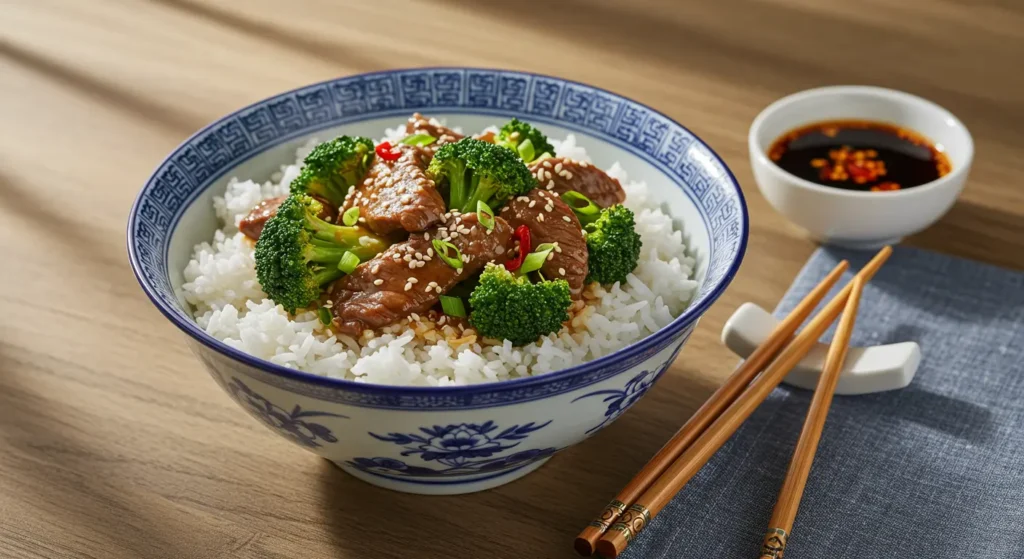The Ultimate Beef and Broccoli Recipe: Better Than Takeout in 20 Minutes
Last Friday at 7 PM, I found myself doing that thing we all do – scrolling through delivery apps, watching the total climb to $48 for what would essentially be two servings of beef and broccoli. That’s when it hit me: I had flank steak in the fridge, a head of broccoli that needed using, and about 15 minutes before everyone started getting hangry. Twenty minutes later, we were eating beef and broccoli that was honestly better than our usual takeout spot. And it cost me about $12 to make enough for four people with leftovers.
Here’s what nobody tells you about beef and broccoli: it’s one of those dishes that seems way more complicated than it actually is. Once you nail the technique (which I’m about to share with you), you can literally make this faster than the delivery driver could get to your house. We’re talking tender, velvety beef that actually tastes like beef, broccoli that’s perfectly crisp-tender instead of soggy, and a sauce that’ll have you licking the plate clean.
The secret isn’t some fancy ingredient or special wok that you need to order from Amazon. It’s all about understanding why Chinese restaurants get that texture we all crave, and how to replicate it with stuff you probably already have. And yes, I’m going to tell you about velveting – that magical technique that makes cheap cuts of beef taste like they came from a $50 steak.

Why This Beef and Broccoli Recipe Actually Works
Before we dive into the recipe, let’s talk about why most homemade beef and broccoli fails, and why this one doesn’t. Because understanding the “why” is what’ll transform you from someone following a recipe to someone who can whip this up without even thinking about it.
The biggest mistake I see people make? They treat beef and broccoli like a regular stir-fry. Just throw everything in a hot pan and hope for the best, right? Wrong. That’s how you end up with tough, chewy beef and broccoli that’s either raw or mushy. Been there, done that, ordered pizza instead.
The magic of restaurant-style beef and broccoli comes down to three things: velveting the beef (I promise it’s not as fancy as it sounds), cooking everything separately, and nailing the sauce consistency. Get these three things right, and you’re golden.
Velveting is this Chinese cooking technique that involves marinating thin slices of meat in cornstarch and a bit of liquid. According to the experts at Serious Eats, this creates a protective coating that keeps the meat tender and gives it that silky texture we associate with good Chinese food. It’s the difference between beef that melts in your mouth and beef that feels like you’re chewing on a rubber band.
And here’s something that took me years to figure out: the order you cook things matters. A lot. Beef first, set aside. Broccoli second, set aside. Sauce in the empty wok, then everything back in for a quick toss. This way, nothing overcooks, everything stays at the right texture, and you look like some kind of stir-fry genius.
Choosing Your Ingredients (And Yes, Substitutions Are Totally Fine)
The Beef: What Really Works
Let’s get real about beef choices. Every recipe online will tell you to use flank steak or sirloin, and yeah, those are great. But you know what? I’ve made killer beef and broccoli with whatever was on sale at the grocery store. The velveting technique is your insurance policy – it makes even cheaper cuts taste expensive.
My go-to is flank steak when it’s on sale (usually around $8-9 per pound at my local Kroger). But I’ve also used:
- Sirloin: A bit more tender, a bit more expensive
- Skirt steak: Works great, just slice it thinner
- Chuck roast: Seriously! Slice it super thin against the grain
- Pre-sliced “stir-fry beef”: Convenient but pricey
The key is slicing against the grain – look for the lines running through the meat and cut perpendicular to them. And thin means thin – we’re talking 1/4 inch max. I freeze my beef for about 20 minutes before slicing. Makes it way easier to get those thin, even slices that cook in literally 30 seconds.

The Broccoli: Fresh vs. Frozen (No Judgment)
Fresh broccoli is ideal, but let’s be honest – sometimes all you have is a bag of frozen florets in the freezer, and that’s totally fine. I’ve made this recipe both ways countless times.
For fresh broccoli, you want florets that are dark green and tight. That yellowing stuff that’s been sitting in your crisper drawer for two weeks? Maybe skip that. Cut them into uniform, bite-sized pieces – about 1 to 1.5 inches. And here’s a pro tip: don’t throw away those stems! Peel them with a vegetable peeler and slice them thin. They’re delicious and it feels less wasteful.
If using frozen, don’t thaw it first. Seriously. Throw it straight from the freezer into the hot wok. It’ll steam and cook perfectly without turning to mush. Just add an extra minute to the cooking time and make sure your wok is really hot.
The Sauce: Where the Magic Happens
The sauce is what ties everything together, and this is where you can really make it your own. My base recipe is simple but perfect:
- 3 tablespoons soy sauce (low sodium if you’re watching salt)
- 2 tablespoons oyster sauce (Lee Kum Kee brand is my favorite)
- 1 tablespoon brown sugar (or honey if you prefer)
- 2 cloves garlic, minced (or 1 teaspoon garlic powder in a pinch)
- 1 teaspoon fresh ginger (or 1/2 teaspoon ground)
- 1 tablespoon cornstarch
- 1/4 cup beef broth (or water, honestly)
- 1 teaspoon sesame oil (the toasted kind – it makes a difference)
Mix everything together in a bowl before you start cooking. Trust me, you won’t have time to be measuring stuff once that wok gets going. And taste it! If you like it sweeter, add more sugar. More savory? Extra soy sauce. This is your dinner, make it how you like it.
The Complete Step-by-Step Beef and Broccoli Method
Step 1: Velvet That Beef (10 minutes, mostly waiting)
Alright, here’s where we turn regular beef into that restaurant-style silky goodness. In a bowl, combine your sliced beef with:
- 1 tablespoon soy sauce
- 1 tablespoon cornstarch
- 1 tablespoon vegetable oil
Mix it all together with your hands – yes, your hands. Get in there and make sure every piece is coated. Let it sit for at least 10 minutes while you prep everything else. This is velveting, and it’s going to change your stir-fry game forever.
The cornstarch creates a barrier that protects the meat from the high heat, while the oil helps it not stick to the pan. The soy sauce adds flavor and helps tenderize. It’s basically magic.
Step 2: Blanch the Broccoli (Or Don’t)
Here’s where recipes get all controversial. Some people bla
nch their broccoli first, some don’t. I do sometimes, depending on my mood and how much time I have.
If blanching: Bring a pot of salted water to boil, throw in your broccoli for 60 seconds, then immediately transfer to ice water. This gives you bright green, perfectly crisp-tender broccoli every time.
If not blanching: Just cook it a bit longer in the wok. It’ll still be great, just maybe not as vibrantly green. No judgment here – I skip this step on Tuesday nights all the time.

Step 3: The Actual Cooking (5 minutes of pure action)
This is where everything happens fast, so have everything ready to go. And I mean everything – your aromatics minced, your sauce mixed, your family out of the kitchen so they’re not in your way.
Heat your wok or largest skillet over high heat. And when I say high, I mean HIGH. This is not the time to be timid. Add a tablespoon of oil with a high smoke point (vegetable, canola, or peanut oil all work great). The oil should shimmer and almost smoke.
Add your beef in a single layer. Don’t touch it! Let it sear for about 30 seconds, then stir-fry for another 30 seconds until it’s just cooked through. Remove it to a plate.
Add another tablespoon of oil if needed. Throw in your broccoli and stir-fry for 2-3 minutes if raw (1-2 if blanched). You want it bright green and crisp-tender. Remove to the plate with the beef.
Step 4: Bringing It All Together
Lower the heat to medium. If there’s no oil left in the pan, add a tiny bit more. Give your sauce a quick stir (the cornstarch settles), then pour it into the center of the wok.
It’ll bubble and thicken almost immediately – this is normal, don’t panic. Add your beef and broccoli back to the wok and toss everything together for about 30 seconds, just until everything’s coated in that glossy sauce.
That’s it. You’re done. Four steps, less than 20 minutes, and you’ve just made beef and broccoli that rivals any takeout place.
Recipe Variations That Keep Things Interesting
The “Level Up” Version
Once you’ve mastered the basic recipe, try these additions that make it feel fancy:
- Add cashews or peanuts in the last 30 seconds
- Throw in some baby corn and water chestnuts
- Use a mix of regular and Chinese broccoli (gai lan)
- Add a tablespoon of black bean sauce to the sauce mixture
- Finish with a drizzle of chili oil for heat
The “Healthier” Version
Look, beef and broccoli is already pretty healthy, but if you want to lighten it up:
- Use less oil for cooking (just be careful things don’t stick)
- Swap brown sugar for a sugar substitute
- Add more vegetables – snap peas, bell peppers, mushrooms all work great
- Use coconut aminos instead of soy sauce
- Serve over cauliflower rice instead of regular rice
The “I Have No Asian Ingredients” Version
We’ve all been there. It’s 7 PM and you realize you’re out of oyster sauce. Here’s my emergency substitution list:
- No oyster sauce? Use hoisin sauce or just extra soy sauce
- No sesame oil? Skip it or use a tiny bit of peanut butter (sounds weird, works great)
- No fresh ginger? Ground ginger works, use half the amount
- No cornstarch? Flour works in a pinch, though the texture won’t be quite the same
- No soy sauce? OK, maybe order takeout
The “Meal Prep Champion” Version
This recipe is actually perfect for meal prep. Cook everything as directed, but slightly undercook the broccoli. Portion into containers with rice. When reheating, the broccoli will finish cooking and still be perfect instead of mushy. I make a triple batch on Sundays and have lunches for most of the week.
Troubleshooting: When Good Beef and Broccoli Goes Bad
“My Beef Is Tough and Chewy”
Three possible culprits here:
- You didn’t slice it thin enough or against the grain
- You skipped the velveting step (don’t skip the velveting!)
- You overcooked it
The fix: Slice thinner next time, always velvet, and remember – beef cooks FAST in a hot wok. We’re talking 1-2 minutes max.
“My Sauce Is Too Thick/Too Thin”
Too thick? Add a splash of water or broth and stir. Too thin? Mix a teaspoon of cornstarch with a tablespoon of water and add it to the pan. The sauce should coat the back of a spoon but still be pourable.
“Everything Tastes Bland”
You probably need more salt. I know, I know, we’re all trying to eat less sodium. But salt is flavor. Start with the recipe amounts and adjust from there. Also, don’t forget that sesame oil – it adds a ton of flavor even though you only use a little.
“My Broccoli Is Mushy/Still Raw”
This is all about timing and heat. Mushy means you cooked it too long or at too low a temperature. Raw means not long enough or your pieces are too big. Aim for florets about 1-inch wide, high heat, and 2-3 minutes of cooking time.
“It Doesn’t Taste Like Restaurant Beef and Broccoli”
The secret ingredient in a lot of restaurant Chinese food? MSG. I’m not afraid of it – it’s basically just another type of salt that adds umami. If you want that true restaurant flavor, add 1/2 teaspoon to your sauce. Or use chicken bouillon powder, which often contains MSG anyway.

Serving Suggestions and Side Dishes
The Classic Route
Over white rice. Done. Next question.
But seriously, the rice is important. Use jasmine rice if you can – it’s fragrant and slightly sticky, perfect for soaking up that sauce. Cook it in chicken broth instead of water for extra flavor. And make extra because everyone always wants more rice with this dish.
The Low-Carb Options
- Cauliflower rice: Actually really good with this. The sauce makes you forget it’s not real rice
- Shirataki noodles: Those zero-calorie noodles from the health food store. Rinse them really well first
- Zucchini noodles: Spiralize them yourself or buy them pre-done
- Just eat it plain: Honestly, it’s good enough to stand alone
The “Make It A Feast” Additions
When I’m trying to impress (in-laws coming over, trying to convince my kids I’m a good cook), I’ll serve beef and broccoli as part of a spread:
- Egg rolls or spring rolls (store-bought is fine, we’re not superheroes)
- Hot and sour soup or egg drop soup
- Fried rice (use day-old rice for best results)
- Pot stickers (again, frozen ones are totally acceptable)
- Those crispy fried wonton strips everyone fights over
The Leftover Strategy
Cold beef and broccoli straight from the fridge at 11 PM is honestly pretty great (no judgment if you’ve been there). But if you want to be civilized about it:
- Reheat in the microwave with a splash of water, covered, at 50% power
- Turn it into fried rice – chop everything up, fry with day-old rice
- Make a wrap with a large tortilla, some crispy lettuce, and extra sauce
- Toss with cooked noodles and a bit of pasta water for Asian fusion
The Nutritional Breakdown (For Those Who Count)
Let’s talk numbers, because beef and broccoli is actually one of those dishes that sounds indulgent but is surprisingly balanced. Per serving (based on 4 servings):
- Calories: About 280
- Protein: 25g (hello, gains)
- Carbs: 15g (not including rice)
- Fat: 12g
- Fiber: 3g
- Iron: 15% daily value
- Vitamin C: 90% daily value (thank you, broccoli)
- Vitamin K: Over 100% daily value
Compare that to the takeout version, which often has twice the calories and three times the sodium. Plus, you know exactly what went into yours – no mystery ingredients or preservatives.
The beef provides high-quality protein and iron, while the broccoli brings vitamins, fiber, and those antioxidants everyone’s always talking about. According to Healthline, the combination of protein and fiber makes this a filling meal that keeps you satisfied longer than your average takeout.
Equipment: What You Really Need (And What You Don’t)
The Essentials
- A large skillet or wok: You don’t need a traditional round-bottom wok. I used a regular non-stick skillet for years. Just make sure it’s big enough that things aren’t crowded
- A sharp knife: For slicing that beef thin. Seriously, sharp makes all the difference
- A cutting board: Preferably two – one for meat, one for vegetables
- Basic measuring spoons: Though honestly, I eyeball most of this now
The “Nice to Have” Items
- A real carbon steel wok: If you want to get serious about stir-frying, this is the upgrade. Season it properly and it’ll last forever
- A wok spatula: That long-handled metal spatula you see in Chinese restaurants. Makes tossing everything together easier
- A spider strainer: Great for scooping out blanched broccoli
- A meat slicer: Overkill? Maybe. But it makes getting uniform thin slices super easy
What You Don’t Need
- A special wok burner (your regular stove is fine)
- A rice cooker (though they are convenient)
- Fancy oils (regular vegetable oil works great)
- Special “stir-fry” sauces from the store (make your own, it’s better and cheaper)
Storage and Meal Prep Tips
Storing Leftovers
Beef and broccoli keeps in the fridge for 3-4 days in an airtight container. The broccoli might lose its vibrant green color, but it’ll still taste good. If storing with rice, keep them in separate compartments or containers – the rice tends to dry out when reheated with the saucy beef and broccoli.
Pro tip: Portion it out right after cooking. It’s easier to grab a single serving for lunch than to try to separate it once it’s cold and the sauce has congealed.
Freezing (Yes, You Can)
Despite what some people say, you can freeze beef and broccoli. Will it be as good as fresh? No. Will it be better than no dinner at all on a crazy Thursday night? Absolutely.
Freeze in single portions in freezer-safe containers for up to 2 months. Leave a little room at the top for expansion. Thaw overnight in the fridge and reheat gently. The broccoli texture suffers a bit, but it’s still totally edible.
Meal Prep Method
Sunday meal prep has saved my sanity more times than I can count. Here’s my system:
- Prep all ingredients but don’t cook (slice beef, cut broccoli, mix sauce)
- Store beef in its marinade, broccoli in a separate container, sauce in a jar
- When ready to cook, it takes literally 5 minutes since everything’s prepped
- Make rice in bulk and portion it out
This way, you get fresh-cooked flavor without the weeknight prep work.
FAQs: Your Beef and Broccoli Questions Answered
Can I use chicken instead of beef?
Absolutely! Use boneless, skinless thighs or breasts, cut into bite-sized pieces. Velvet them the same way. Chicken actually cooks even faster than beef, so watch your timing. My kids actually prefer the chicken version sometimes.
Why is my beef and broccoli not as dark as restaurant versions?
Restaurants often use dark soy sauce or add a touch of molasses for color. You can add a teaspoon of dark soy sauce to your sauce mixture if you want that deeper color. Some places even add a drop of food coloring, but that’s totally unnecessary.
Can I make this in advance for a party?
You can prep everything in advance, but I’d cook it fresh if possible. Stir-fries are best served immediately. If you must cook ahead, slightly undercook everything and reheat gently. Have extra sauce on hand to refresh it.
Is oyster sauce vegetarian?
Nope, it’s made from oysters. For a vegetarian version, use mushroom sauce (sometimes called vegetarian oyster sauce) or hoisin sauce. The flavor’s different but still delicious.
What’s the best rice to serve with beef and broccoli?
Jasmine rice is my favorite – it’s fragrant and slightly sticky. Short-grain rice works too. Brown rice is healthier but takes longer to cook. Whatever you use, rinse it first until the water runs clear for fluffier results.
My Final Thoughts (And a Confession)
Here’s the thing about beef and broccoli – it was actually the first “real” dish I learned to cook when I moved out on my own. Before that, my cooking repertoire consisted of pasta with jarred sauce and anything that came with microwave instructions. But I was spending stupid money on Chinese takeout, and my roommate (who could actually cook) took pity on me.
She taught me this recipe one Sunday afternoon, and I’m not exaggerating when I say it changed my relationship with cooking. Because here’s what beef and broccoli taught me: restaurant food isn’t magic. It’s just technique. Once you understand the why behind the what, you can make anything.
These days, I can make beef and broccoli with my eyes closed. My kids request it at least once a week, and my husband claims it’s better than his favorite Chinese place (though he might be biased). But the best part? Every time I make it, I remember standing in that tiny apartment kitchen, amazed that I’d just made “real” food.
So whether you’re a college student trying to adult, a parent looking for something everyone will actually eat, or just someone who loves good Chinese food but hates the delivery fees, this recipe’s for you. It’s forgiving enough for beginners but good enough to impress. And once you nail it, you’ll never order beef and broccoli again.
Well, maybe never is too strong. We all have those nights where even 20 minutes feels like too much. But most nights? You’ve got this. Your wok (or skillet) is waiting, that beef isn’t going to velvet itself, and dinner’s just 20 minutes away.
Now go make some beef and broccoli that’ll make your local Chinese restaurant nervous. And when someone asks for your secret, just smile and tell them it’s all in the velveting. They’ll think you’re some kind of culinary genius. You’re welcome.
